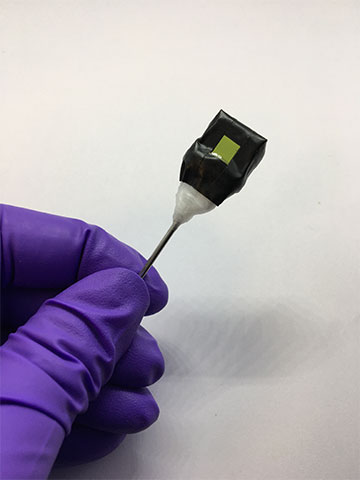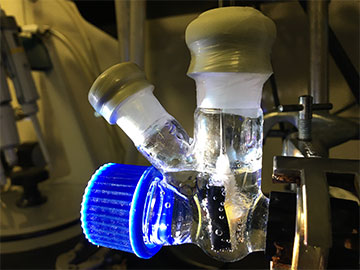
Researchers at the University of Cambridge, UK, developed an artificial leaf as a standalone device that converts carbon dioxide and water into drop-in liquid fuel. [Image: M. Rahaman]
Bioethanol is often referred to as a cleaner alternative to gasoline because it is produced from plants. However, its production takes up agricultural land that could otherwise be used to grow food, so its status as a “green” fuel has been somewhat controversial.
Now researchers at the University of Cambridge, UK, have reportedly harnessed the power of sunlight to turn carbon dioxide and water into alcohols using an artificial leaf inspired by photosynthesis (Nat. Energy, doi: 10.1038/s41560-023-01262-3). The alcohols have high energy density and produce less harmful emissions than gasoline, and they could be added straight into cars as a drop-in fuel.
“Shining sunlight on the artificial leaves and getting liquid fuel from carbon dioxide and water is an amazing bit of chemistry,” said first author Motiar Rahaman in a press release accompanying the research. “It’s an exciting advance that opens up whole new avenues in our work.”
A catalyst and tandem light absorbers
Using an artificial leaf for the solar-driven conversion of carbon dioxide into multicarbon alcohols in a single step has been a goal of scientists. Thus far, however, artificial leaves have only been able to produce simple chemicals such as synthetic gas, or syngas. This mixture of hydrogen and carbon monoxide often serves as an intermediary substance that needs to be turned into a drop-in liquid fuel.

The wireless standalone artificial leaf surrounded by aqueous carbon dioxide and water under simulated sunlight. [Image: M. Rahaman]
To improve the artificial photosynthesis technology, the researchers first used copper and palladium to develop a catalyst. Both the theoretical calculation and operando Raman spectroscopy of the Cu94Pd6 catalyst confirmed that it is suitable for generating multicarbon alcohols.
The Cambridge team then integrated the catalyst with perovskite–BiVO4 tandem light absorbers. When the resulting artificial leaves were exposed to simulated sunlight with the intensity of 1 sun for 20 hours (where the light was repeatedly switched on for 50 minutes and off for 10 minutes) while submerged in aqueous carbon dioxide and water, a leaf connected to copper wires generated a 1:1 mixture of ethanol and n-propanol with a Faradaic efficiency of about 7.5%. When a wireless standalone device underwent the same process, it produced approximately 1 μmol/cm2 of the alcohols with a rate of about 40 μmol/h×gCu94Pd6.
Complex chemicals from artificial leaves
According to the press release, this is the first time that complex chemicals such as multicarbon alcohols have been produced with an artificial leaf using only solar energy. But the Cambridge team’s leaf is still at a proof-of-concept stage, and therefore its efficiency is described as “modest.”
According to the press release, this is the first time that complex chemicals such as multicarbon alcohols have been produced with an artificial leaf using only solar energy.
The researchers are currently working to improve the catalyst and light absorbers so that the resulting leaf can better absorb sunlight and produce the alcohols with a higher efficiency. And to produce a large amount of fuel, the device will also need to be scalable.
“Even though there’s still work to be done, we’ve shown what these artificial leaves are capable of doing,” said team lead Erwin Reisner in the press release. “It’s important to show that we can go beyond the simplest molecules and make things that are directly useful as we transition away from fossil fuels.”
